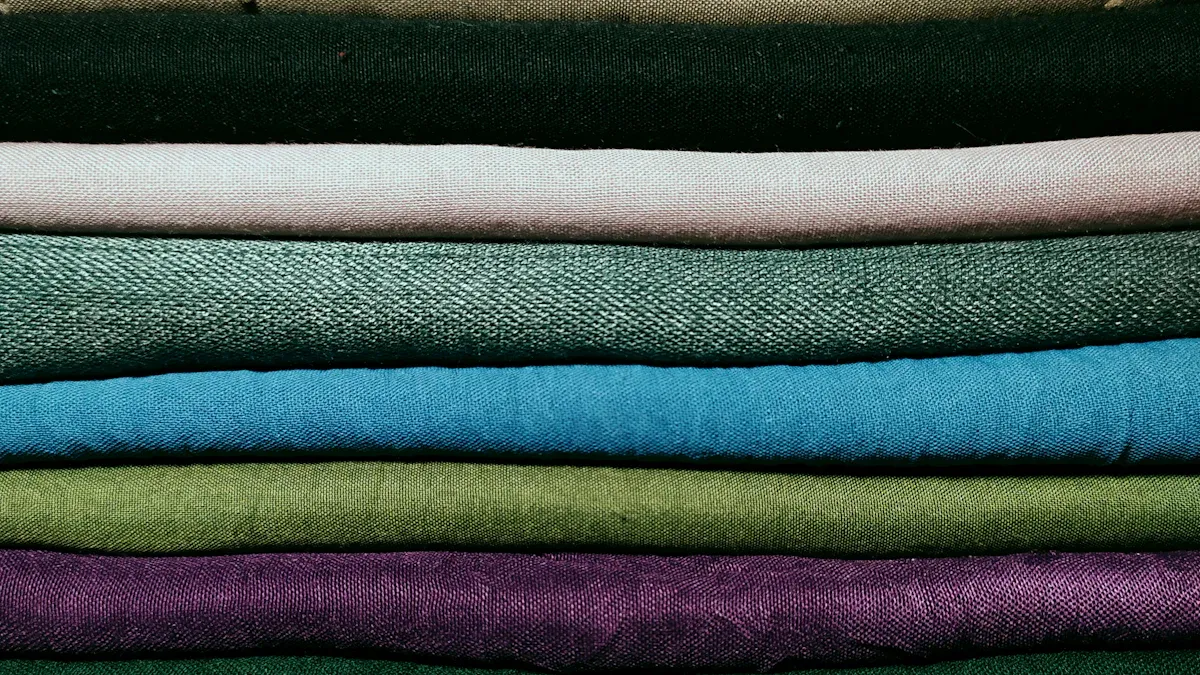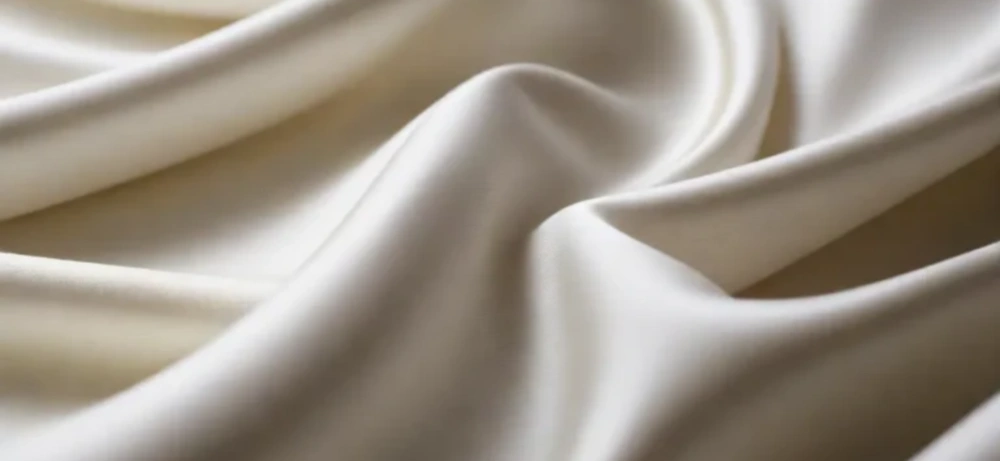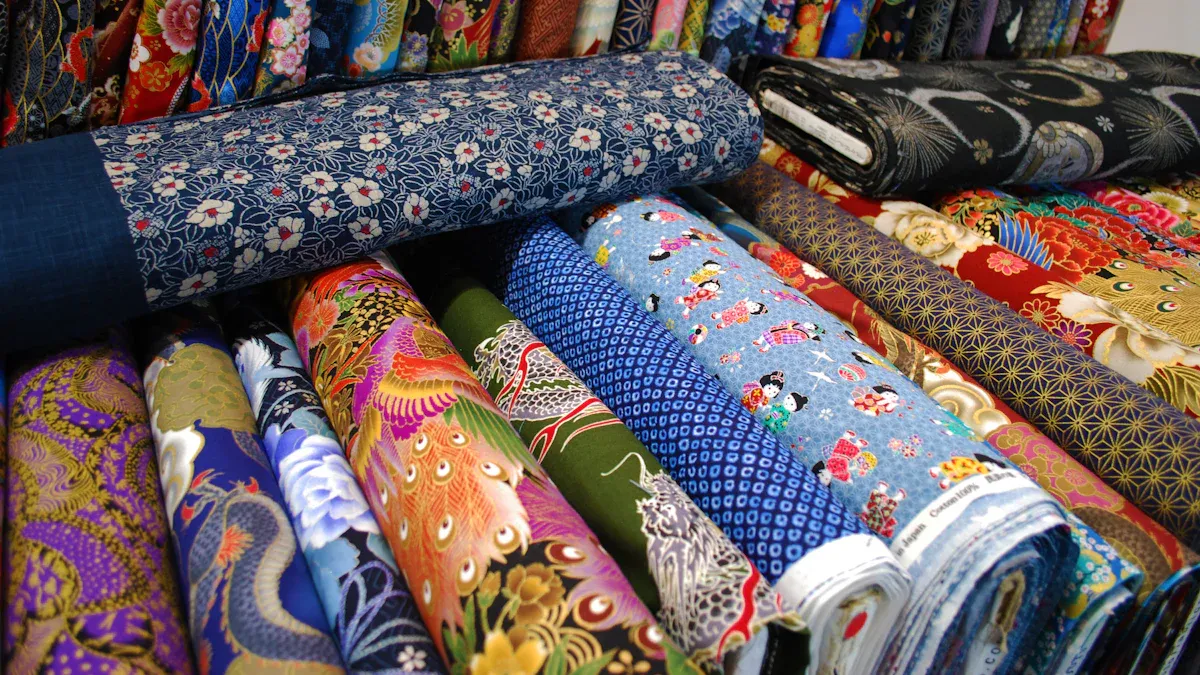
Choosing between milk silk fabric vs cotton really comes down to your lifestyle and what you value most. If you want a silky, smooth feel and easy care, milk silk fabric vs cotton gives you that luxury touch.
Cotton stands out for breathability and comfort, especially if you have sensitive skin or want something classic. Both fabrics have unique strengths. You can pick the one that fits your needs best, whether you care most about softness, price, or how eco-friendly your choice is.
Key Takeaways
Milk silk fabric offers a silky, soft feel that stays smooth after many washes, making it great for sensitive skin and luxury comfort.
Cotton is breathable, comfortable, and easy to care for, making it a reliable and budget-friendly choice for everyday wear.
Milk silk fabric wicks moisture quickly and keeps you cool, ideal for hot weather and people who sweat at night.
Cotton is durable and easy to wash, but may shrink or wrinkle if not cared for properly; air drying helps it last longer.
Choose milk silk for a luxurious, gentle fabric with eco-friendly benefits, or pick cotton for classic comfort and versatility.
Milk Silk Fabric vs Cotton
Key Features
When you compare milk silk fabric vs cotton, you want to look at what matters most for your daily comfort and style. Here’s a quick table to help you see the main differences at a glance:
Feature | Milk Silk Fabric | Cotton |
|---|---|---|
Softness & Comfort | Silky, smooth, gentle on skin; feels like luxury | Soft, breathable, classic comfort; pure cotton feels cozy and familiar |
Breathability | Highly breathable; keeps you cool and dry | Breathable and airy, pure cotton lets your skin breathe |
Durability | Strong and resistant to wear; keeps its shape well | Durable, but pure cotton can weaken with heat or over time |
Care | Needs gentle care; hand wash and air dry for best results | Easy to care for; machine washable and simple to maintain |
Price | Usually more expensive due to the complex process | More affordable; pure cotton is widely available |
Eco-Friendliness | Biodegradable if made chemical-free; uses less water than cotton | Traditional cotton uses lots of water and pesticides; organic cotton is better |
Best Uses | Great for luxury sleepwear, loungewear, and sensitive skin | Perfect for everyday wear, pajamas, and classic styles |
Tip: If you want pajamas that feel like silk but are easier to care for, check out Friendtex’s Modal Pajamas. For a classic, high-quality option, Friendtex Pima Cotton Pajamas and Cotton Nightgowns for Women are always a safe bet.
You’ll notice that milk silk fabric stands out for its silky feel and moisture-wicking properties. It’s also strong and keeps its color well, so your clothing fabric looks fresh longer.
Cotton, especially pure cotton, is a favorite for breathability and comfort. It’s easy to wash and works for almost any season. If you want something eco-friendly, look for organic cotton or milk silk fabric made with modern, chemical-free methods.
When you choose between milk silk fabric vs cotton, think about what you value most—softness, easy care, price, or eco-friendliness. Friendtex offers both options, so you can find the perfect fit for your needs.
Comfort & Feel
Softness

When you slip into pajamas or loungewear, you want that instant feeling of comfort. Milk silk fabric stands out for its soft and silky texture. It feels cool and smooth against your skin, almost like a gentle caress. If you love a delicate and soft feel, milk silk gives you that little touch of luxury every time you wear it.
Cotton, on the other hand, offers a cozy and familiar softness. Pure cotton feels natural and breathable, making it a favorite for many people who want to wear comfortable clothes all day.
You might notice that milk silk keeps its softness even after many washes. It resists pilling and stays smooth, so your clothes look and feel new longer.
Cotton can start soft, but sometimes it loses that plushness over time, especially if you use hot water or high heat in the dryer. If you want pajamas that always feel fresh and gentle, milk silk fabric is a great choice for personal comfort.
Tip: If you want pajamas that feel like silk but are easy to care for, Friendtex Modal Pajamas are a smart pick.
Skin Sensitivity
If you have sensitive skin, you know how important it is to pick the right fabric. Milk silk fabric is known for being skin-friendly. It has a very low surface friction, which means it glides over your skin and helps prevent irritation. Cotton is also gentle, but some people find that it can feel rough after many washes or if it’s not high quality.
Here’s a quick look at how milk silk and cotton compare for sensitive skin:
Parameter | Milk Silk Fabric (TPU Composite) | Cotton |
|---|---|---|
Surface Friction Coefficient | ≤0.15 (less irritation) | 0.3-0.4 |
Breathability (g/m²/24h) | 2000 (very breathable) | 1500 |
Skin-Friendly Rating | ★★★★★☆ | ★★☆☆☆ |
Washing Stability | Excellent | Poor |
You can see that milk silk fabric offers better breathability and a higher skin-friendly rating. It’s a top pick if you want to avoid itchiness or redness. Cotton works well for most people, but if you have extra sensitive skin, milk silk or modal pajamas from Friendtex can help you wear comfortable clothes without worry.
Breathability & Moisture
Airflow
When you pick out pajamas or loungewear, you want something that lets your skin breathe. Airflow makes a huge difference in how comfortable you feel, especially if you tend to get warm at night. Milk silk fabric and cotton both do a good job here, but they feel a bit different.
Milk silk fabric has a super fine weave. This lets air move through easily, so you don’t feel stuffy or overheated. You’ll notice that milk silk feels cool to the touch, which is perfect if you sleep hot or live in a warm climate.
Cotton, on the other hand, is famous for its natural breathability. Pure cotton lets air circulate well, keeping you comfortable in almost any season.
Here’s a quick comparison:
Fabric | Airflow Rating | Best For |
|---|---|---|
Milk Silk Fabric | ★★★★★ | Hot sleepers, summer |
Cotton | ★★★★☆ | Year-round, all climates |
Tip: If you want pajamas that keep you cool and fresh, Friendtex Modal Pajamas and Silk Nightgowns for Women are great choices for airflow.
Sweat Absorption
Let’s talk about sweat. Nobody likes waking up feeling damp or sticky. The way your fabric handles moisture can make or break your sleep.
Milk silk fabric does a great job of wicking moisture away from your skin. It pulls sweat to the surface, where it can evaporate quickly. You stay dry and comfortable, even on those muggy nights. Cotton absorbs sweat well, too. It soaks up moisture and keeps it away from your skin, but sometimes it can feel heavy if you sweat a lot.
Here’s what you need to know:
Milk silk fabric: Wicks moisture, dries fast, feels light.
Cotton: Absorbs sweat, feels soft, but can get damp if you sweat a lot.
If you want pajamas that help you stay dry all night, milk silk fabric is a smart pick. For classic comfort and reliable sweat absorption, cotton is always a safe bet. You get to choose what feels best for you!
Durability & Care
Longevity
When you invest in pajamas or loungewear, you want them to last. Milk silk fabric feels luxurious, but it needs a little extra care to keep its softness and shape. If you treat it gently, you can enjoy that silky feel for a long time. Always wash milk silk in lukewarm water with a mild detergent.
Hand washing works best. Avoid rubbing or wringing the fabric. After washing, roll your garment in a towel to remove extra water, then lay it flat to air dry away from sunlight. This helps prevent fading and keeps the fibers strong.
Cotton, on the other hand, is known for its durability. You can usually toss cotton pajamas in the washing machine without worry. Cotton stands up well to regular wear and washing, especially if you use cold water and gentle cycles.
Air drying cotton helps it last even longer and keeps it from shrinking. If you follow these steps, both fabrics can stay in great shape, but milk silk needs a bit more attention to maintain its overall performance.
Tip: Store milk silk garments on padded hangers in a cool, shaded spot. This keeps them from stretching or getting damaged.
Maintenance
Taking care of your clothes doesn’t have to be hard. For milk silk, stick to gentle routines. Use silk-specific or neutral pH detergents, and skip harsh chemicals like bleach or fabric softeners. If you need to iron, use the lowest heat setting and place a cloth between the iron and the fabric.
Cotton is easier to maintain. Wash after two or three wears, or when it looks dirty. Use cold water and short cycles to save energy and keep the fabric strong.
Air drying is best for both your clothes and the planet. Regular care not only keeps your pajamas looking fresh but also helps the environment by reducing waste and energy use.
Note: Proper care for both fabrics means you won’t have to replace your favorite pajamas as often, which is good for your wallet and the earth.
Price & Value
Cost
Let’s talk about what you’ll pay at checkout. Milk silk fabric usually costs more than regular cotton. The process to make milk silk is more complex, and the fabric feels more luxurious. If you pick pajamas or loungewear made from milk silk, you’ll notice the price tag reflects that extra softness and shine.
Cotton, on the other hand, is everywhere. You can find cotton pajamas at almost any price point. Basic cotton is affordable, while premium types like Pima cotton cost a bit more. If you want something budget-friendly, cotton is a safe choice. If you want a treat or a special gift, milk silk fabric gives you that high-end feel.
Here’s a quick look:
Fabric | Average Price Range | Friendtex Example |
|---|---|---|
Milk Silk Fabric | $ – $$ | |
Cotton | $ – $ | Pima Cotton Pajamas, Cotton Nightgowns for Women |
Tip: If you want luxury without breaking the bank, check out Friendtex’s Modal Pajamas. They feel silky but cost less than pure silk or milk silk.
Long-Term Worth
Now, let’s think about value over time. You want pajamas that last, feel good, and stay looking fresh. Milk silk fabric holds its shape and color well. If you care for it gently, it keeps that silky feel for years. You might pay more upfront, but you get a long-lasting, elegant piece.
Cotton is tough and easy to wash. It stands up to lots of wear and tear. If you pick high-quality cotton, like Pima cotton from Friendtex, you get pajamas that stay soft and strong after many washes. Cotton nightgowns are a classic for a reason—they work year after year.
Choose milk silk fabric if you want a luxury feel and don’t mind a little extra care.
Pick cotton if you want something reliable, easy to wash, and budget-friendly.
Note: Investing in quality pajamas from Friendtex means you get comfort, style, and durability—no matter which fabric you choose.
Milk Silk Fabric vs Cotton: Best Uses

Everyday Wear
When you pick out clothes for daily life, you want something that feels good and looks great. Milk silk fabric and cotton both have their place in your closet, but they shine in different ways.
Milk silk fabric gives you a smooth, almost creamy touch. You’ll notice how it drapes beautifully, making it perfect for blouses, skirts, and even linings in jackets or suits. If you want a little luxury in your everyday look, try adding a milk silk top or a pair of silk pajamas for women from Friendtex.
These pieces feel elegant but still work for daily routines. You can also find milk silk in accessories like scarves, which add a touch of shine and softness to any outfit.
Cotton is the classic choice for everyday wear. Pure cotton feels soft, breathable, and light, so you stay comfortable all day. You’ll see cotton everywhere—T-shirts, casual dresses, and pajamas. Friendtex’s Pima Cotton Pajamas and Cotton Nightgowns for Women are great examples.
They’re easy to care for and perfect for busy mornings or relaxing evenings. Cotton works well for looser silhouettes, so you never feel restricted in your clothes.
Here’s a quick table to help you decide:
Fabric Type | Best Everyday Uses | Key Benefits | Friendtex Example |
|---|---|---|---|
Milk Silk Fabric | Blouses, skirts, linings, accessories, pajamas | Luxury feel, elegant drape, soft touch | Silk Pajamas for Women, Silk Nightgowns |
Cotton | T-shirts, casual dresses, pajamas, nightgowns | Breathable, versatile, easy care | Pima Cotton Pajamas, Cotton Nightgowns for Women |
Tip: If you want something that feels like silk but is easy to wash, check out Friendtex Modal Pajamas. They combine comfort and style for everyday wear.
Seasonal Suitability
Seasons change, and so do your clothing needs. The right fabric keeps you comfortable, whether it’s hot and humid or cool and crisp.
Milk silk fabric feels lightweight and cool, making it a smart pick for summer. The fine weave lets air flow, so you don’t overheat. Studies show that silk fabrics, especially when modified, can help with radiative cooling and wick away sweat fast.
You’ll love milk silk for hot nights or warm climates. Silk nightgowns from Friendtex are a great choice if you want to stay cool and comfortable while you sleep.
Cotton is a year-round favorite. Pure cotton keeps you cool in summer and cozy in winter. The fabric breathes well, so you don’t get sweaty, but it also holds warmth when you layer up.
Cotton’s versatility makes it perfect for spring and fall, too. You can wear cotton nightgowns for women in any season, and they always feel right. If you want something extra soft and durable, Pima cotton pajamas from Friendtex are a solid pick.
Let’s break it down:
Hot Weather:
Choose milk silk fabric or silk nightgowns for a cool, airy feel.
Pure cotton works well, especially in loose styles.
Cooler Weather:
Layer up with cotton pajamas or nightgowns.
Cotton holds warmth and feels cozy against your skin.
All Seasons:
Modal pajamas from Friendtex offer a silky touch and work in any climate.
Note: If you live somewhere with big temperature swings, keep both milk silk and cotton options in your wardrobe. You’ll always have the right clothing fabric for the season.
You don’t have to pick just one. Mix and match milk silk and cotton in your closet. Try a milk silk blouse for a special day or stick with pure cotton for everyday comfort. Friendtex has you covered with premium choices for every season and style.
Milk Silk Fabric: Pros & Cons
Advantages
When you look for something soft and gentle, milk silk fabric stands out. You get a fabric that feels smooth and cool, almost like a second skin. Many people love how it combines softness, breathability, and hypoallergenic properties. This makes it a top pick for luxury pajamas, underwear, and even home textiles.
You’ll notice a natural sheen that gives your clothes a premium look.
The fabric keeps you comfortable by balancing skin humidity and absorbing moisture.
Milk silk holds color well, so your pajamas stay bright and fresh after many washes.
It resists wrinkles and pilling, which means less ironing and longer-lasting clothes.
The amino acids from milk protein help protect your skin, making it a great choice if you have sensitive skin.
You get warmth in winter, but the fabric still feels light and breathable.
Many people choose milk silk for its eco-friendly production and sustainable appeal.
If you want pajamas that feel luxurious but are easier to care for than pure silk, milk silk fabric is a smart choice.
Drawbacks
While milk silk has many benefits, you should know about a few challenges. Some users notice a slight sour milk smell when the fabric gets damp. This happens because of the natural protein fibers. If you leave milk silk fabric wet for too long, it can mildew or develop an odor.
The fibers lose strength when wet, so you need to handle them gently during washing.
Milk silk does not like alkaline substances, so avoid harsh detergents.
If you don’t dry it quickly, the fabric may mildew, especially in humid places.
You can avoid most issues by following care instructions and keeping your milk silk items dry and clean. With the right care, you’ll enjoy all the unique properties this fabric offers.
Cotton: Pros & Cons
Advantages
You probably reach for cotton when you want something soft, cool, and comfortable. There’s a good reason for that. Cotton feels gentle on your skin and lets your body breathe, which makes it perfect for pajamas, T-shirts, and everyday clothes.
If you have sensitive skin, you’ll love how pure cotton doesn’t trap heat or cause irritation. It pulls moisture away from your body, so you stay dry and fresh.
Many people care about the planet, and cotton is a smart choice here too. Studies show that cotton is biodegradable, so it breaks down in water and soil instead of adding to pollution. Unlike synthetic fabrics, cotton doesn’t shed microplastics when you wash it.
That means you help keep the environment cleaner just by choosing cotton. In fact, most shoppers say they prefer cotton for its comfort and eco-friendly qualities. You can feel good about wearing it and know you’re making a responsible choice.
Did you know? About 75% of people are willing to pay more for clothes made from natural fibers like cotton because of their softness, quality, and sustainability.
Drawbacks
Cotton has a lot going for it, but it’s not perfect. You might notice that cotton wrinkles easily, so you may spend extra time ironing your favorite shirt or nightgown. After washing, cotton can shrink, especially if you use hot water or high heat in the dryer. Sometimes, pure cotton loses its shape or stretches out when wet.
Here are a few things to watch out for:
Cotton dries slowly because it absorbs a lot of water.
It can lose its insulation and feel cold if it stays damp.
The fabric may not last as long as some synthetics, especially if you wear and wash it often.
Cotton can wrinkle and crease, so you might need to iron it more than other fabrics.
It’s also prone to shrinking and can deform if not cared for properly.
If you want your cotton clothes to last, wash them in cold water and air dry when you can. This helps keep them soft and looking new.
Conclusion
Choosing between milk silk fabric and cotton depends on what matters most to you. If you want the softest feel, less friction on your skin and hair, and a hypoallergenic option, milk silk stands out.
Cotton gives you classic comfort, breathability, and is more budget-friendly. For eco-conscious shoppers, milk silk uses less water and fewer chemicals than cotton.
If you want pajamas or nightgowns that match your needs, check out Friendtex’s premium options. You’ll find both milk silk and cotton styles, so you can pick what feels best for you every night.
FAQ
What’s the main difference between milk silk fabric and cotton?
Milk silk feels silky and smooth, almost like real silk. Cotton feels soft and breathable, giving you that classic comfort. You’ll notice milk silk drapes better, while cotton works for everyday wear.
Is milk silk fabric good for sensitive skin?
Yes! Milk silk is gentle and hypoallergenic. It glides over your skin and helps prevent irritation. If you have sensitive skin, you’ll love how soft and soothing it feels.
How do I wash milk silk and cotton pajamas?
For milk silk, hand wash in cold water and air dry. Use a mild detergent. For cotton, machine wash in cold water and tumble dry low. Always check the care label first.
Which fabric is better for hot weather?
You’ll stay cooler in milk silk or lightweight cotton. Both fabrics breathe well, but milk silk feels cooler to the touch. Cotton works great for summer, especially in loose styles.
Can I find eco-friendly options for both fabrics?
Absolutely! Look for organic cotton or milk silk made with eco-friendly processes. Friendtex offers sustainable choices in both fabrics, so you can feel good about your purchase.


